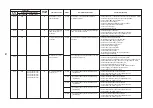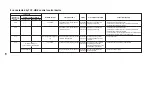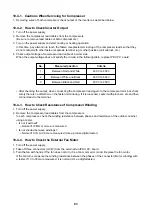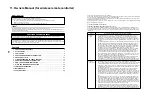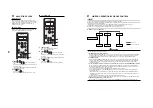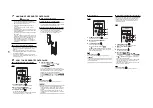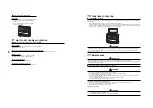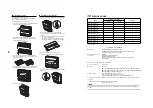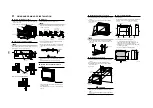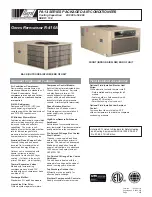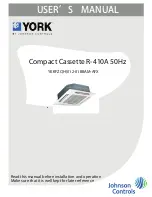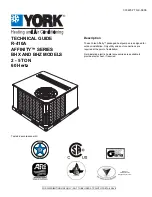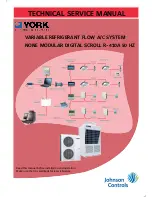
EN
Warning indication
Description
WARNING
ELECTRICAL SHOCK HAZARD
Disconnect all remote electric power supplies before
servicing.
WARNING
Moving parts.
Do not operate unit with grille removed.
Stop the unit before the servicing.
CAUTION
Do not touch the aluminum fi ns of the unit.
Doing so may result in injury.
Warning Indications on the Air Conditioner Unit
WARNING
ELECTRICAL SHOCK HAZARD
Disconnect all remote electric
power supplies before servicing.
WARNING
Moving parts.
Do not operate unit with grille
removed.
Stop the unit before the servicing.
CAUTION
Do not touch the aluminum fi ns
of the unit.
Doing so may result in injury.
1112750101_(01_EN).indd 3
12/21/10 8:38 AM
1
PRECAUTIONS FOR SAFETY
The manufacturer shall not assume any liability for the damage caused by not observing the description of this manual.
WARNING
General
• Carefully read Owner’s Manual before starting the air conditioner. There are many important things to keep in mind
for daily operation.
• Do not use any refrigerant different from the one specifi ed forcomplement or replacement. Otherwise, abnormally
high pressure may be generated in the refrigeration cycle, which may result in a failure or explosion of the product or
an injury to your body.
Transportation and storage
• When transporting the air conditioner, wear shoes with additional protective toe caps.
• When stacking the packing cartons for storage or transportation, heed the precautions written on the packing cartons.
Failure to heed the precautions may cause the stack to collapse.
• When transporting the air conditioner, transport it by two people or more.
Installation
• Only a qualifi ed installer(*1) or qualifi ed service person(*1) is allowed to install the air conditioner. If the air conditioner
is installed by an unqualifi ed individual, a fi re, electric shocks, injury, water leakage, noise and/or vibration may result.
• After the installation work has been completed, have the installer explain about the circuit breaker positions. In the
event that trouble has occurred in the air conditioner, set the circuit breaker to the OFF position, and contact a
service person.
• If you install the unit in a small room, take appropriate measures to prevent the refrigerant from exceeding the limit
concentration even if it leaks. Consult the dealer from whom you purchased the air conditioner when you implement
the measures. Accumulation of highly concentrated refrigerant may cause an oxygen defi ciency accident.
• Do not install the air conditioner in a location that may be subject to a risk of exposure to a combustible gas. If a
combustible gas leaks and becomes concentrated around the unit, a fi re may occur.
Operation
• Before opening the front panel of the indoor unit or service panel of the outdoor unit, set the circuit breaker to the
OFF position. Failure to set the circuit breaker to the OFF position may result in electric shocks through contact with
the interior parts. Only a qualifi ed installer(*1) or qualifi ed service person(*1) is allowed to remove the front panel of
the indoor unit or service panel of the outdoor unit and do the work required.
• Inside the air conditioner are high-voltage areas and rotating parts. Due to the danger of electric shocks or of your
fi ngers or physical objects becoming trapped in the rotating parts, do not remove the front panel of the indoor unit
or service panel of the outdoor unit. When work involving the removal of these parts is required, contact a qualifi ed
installer or a qualifi ed service person.
• Do not move or repair any unit by yourself. Since there is high voltage inside the unit, you may get electric shock
when removing the cover and main unit.
• Never insert a stick into the air intake or outlet. Doing so may result injury as the fan is rotating at high speed inside
the unit.
• Do not expose your body to cool air directly for a long time and do not cool yourself excessively. Doing so may result
in deteriorated physical condition and ill health.
• Do not touch the aluminum fi n of the unit. You may injure yourself if you do so. If the fi n must be touched, do not
touch it yourself but contact a qualifi ed installer or a qualifi ed service person.
• Do not spill water or other liquid on the indoor unit. If the unit is wet, it may cause an electric shock.
• Do not place any combustion appliance in a place where it is directly exposed to the wind of air conditioner, otherwise
it may cause imperfect combustion.
• When the air conditioner is operated with a combustion appliance in the same place, be careful of ventilation to let
fresh air enter the room. Poor ventilation causes oxygen shortage.
• When the air conditioner is used in a closed room, be careful of suffi cient ventilation of the room. Poor ventilation
causes oxygen shortage.
Repairs
• When you have noticed that some kind of trouble (such as when an error display has appeared, there is a smell of
burning, abnormal sounds are heard, the air conditioner fails to cool or heat or water is leaking) has occurred in the
air conditioner, do not touch the air conditioner yourself but set the circuit breaker to the OFF position, and contact a
qualifi ed service person. Take steps to ensure that the power will not be turned on (by marking “out of service” near
the circuit breaker, for instance) until qualifi ed service person arrives. Continuing to use the air conditioner in the
trouble status may cause mechanical problems to escalate or result in electric shocks, etc.
• If you have discovered that there is a danger of the indoor unit’s falling, do not approach the indoor unit but set the
circuit breaker to the OFF position, and contact a qualifi ed installer or a qualifi ed service person to refi t the unit. Do
not set the circuit breaker to the ON position until the unit has been refi tted.
• Do not modify the products. Do not also disassemble or modify the parts. It may cause a fi re, electric shock or injury.
Relocation
• When the air conditioner is to be relocated, do not relocate it yourself but contact a qualifi ed installer or a qualifi ed
service person. Failure to relocate the air conditioner properly may result in electric shocks and/or a fi re.
(*1) Refer to the “Defi nition of Qualifi ed Installer or Qualifi ed Service Person.”
1112750101_(01_EN).indd 4
12/15/10 1:21 PM
86





